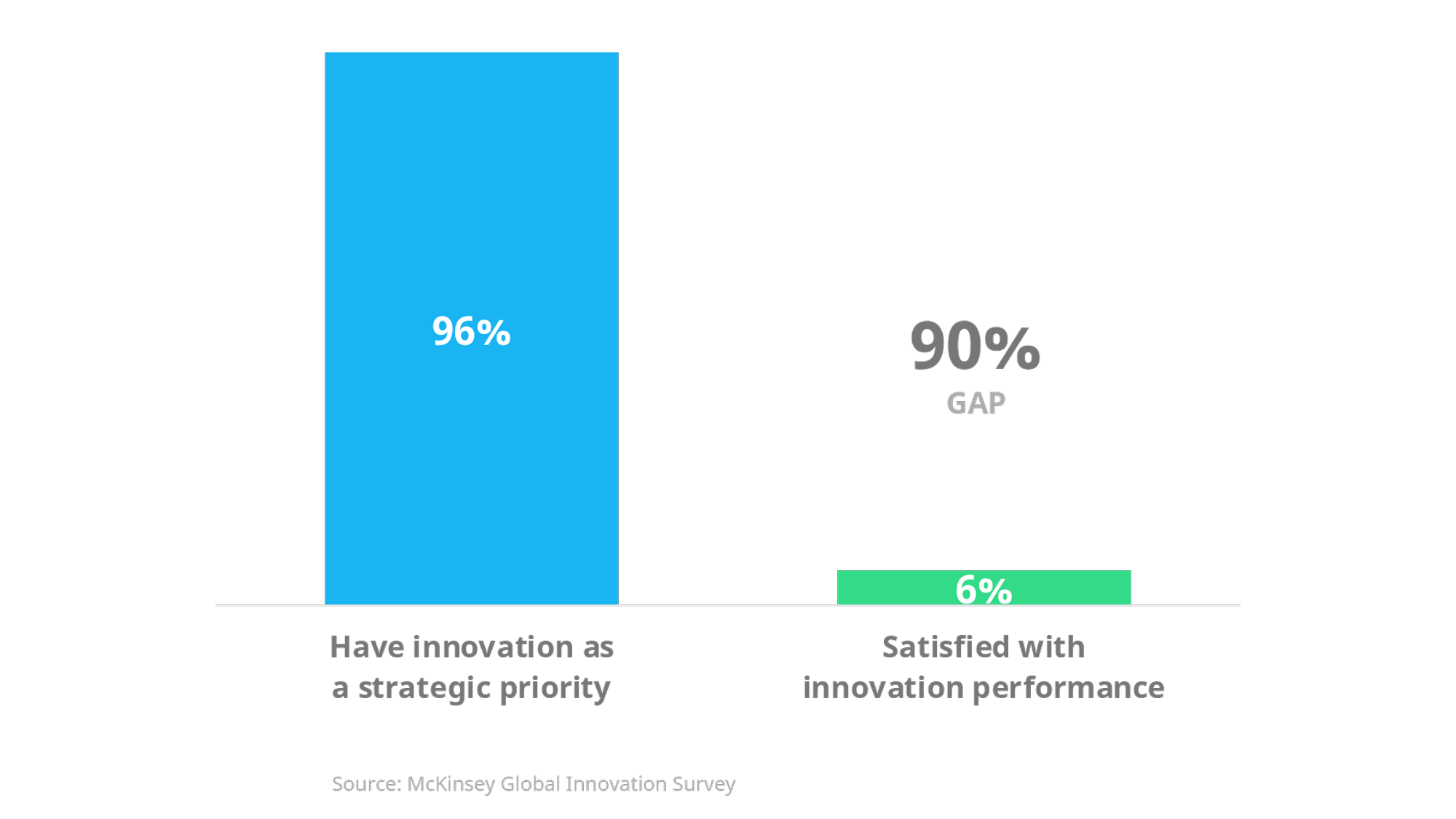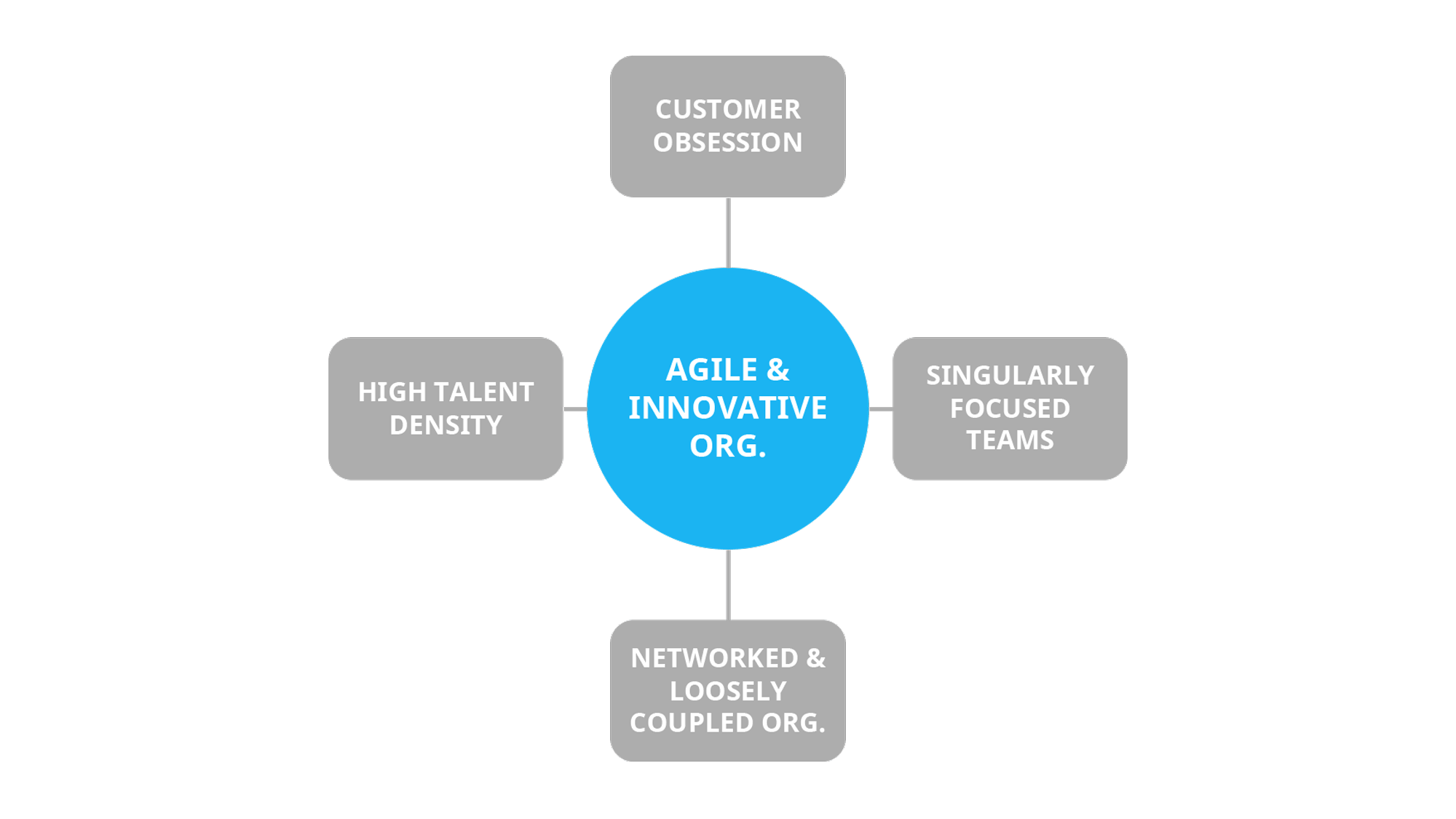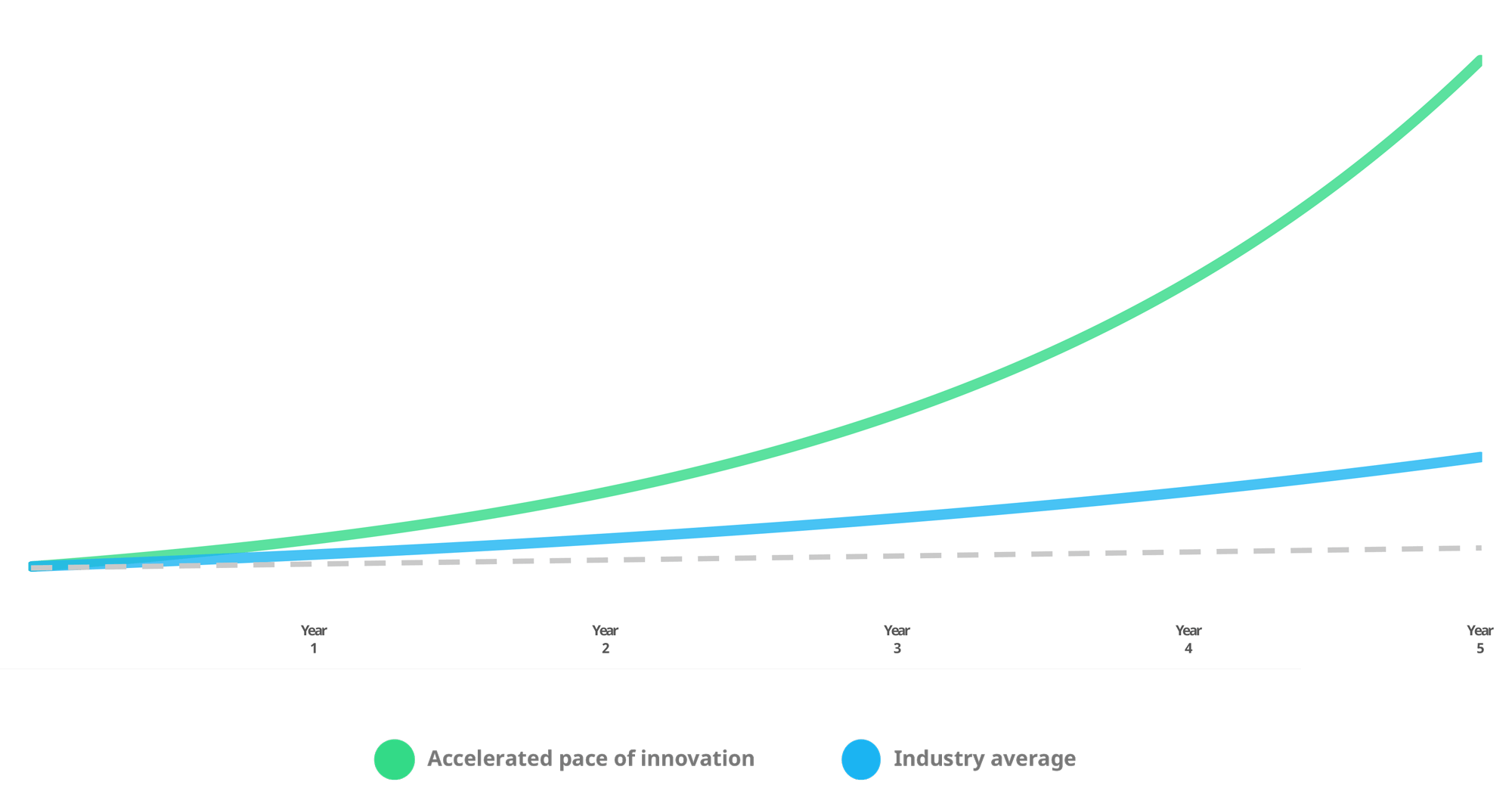Building an Agile & Innovative Organization
In recent years, more and more companies have realized the need for innovation as they’ve seen businesses all around them, and perhaps even their own business, being disrupted.
According to McKinsey research, 96% of executives have made innovation a strategic priority, yet only 6% are satisfied with their innovation performance. There’s a huge discrepancy between these figures, and obviously a part of that comes down to innovation just being hard, and a part to these executives setting the bar high, which certainly makes sense. Regardless, the gap is still huge.

What makes this so difficult for large organizations is that a single innovation just isn’t enough to turn the course of the company. To get the outcomes the executives are expecting from innovation, they’d need to build an agile organization where innovation happens at scale.
Unfortunately, that’s a lot easier said than done. In this article, we’ll first explore what that kind of an organization really looks like, and then look into some of the ways you can find to start shaping your organization to that direction.
What makes an organization innovative?
As so many organizations are embarking on this journey towards becoming more innovative and agile, there’s unfortunately a lot of fake agile and innovation theater out there.
As Steve Blank well put it in his article, reorganizations, new innovation activities, and process reforms, are all useful tools that usually need to be a part of the transformation plan, but they’re not enough without a strategy, mindset, and culture for innovation.
So, what is it exactly that makes an organization innovative and agile?

Well, by definition, innovation is the introduction of anything new. So, an innovative and agile organization is one that can change, adapt, and constantly introduce new things, be it improved, products, services, or processes, that create more value.
An innovative and agile organization is able to change, adapt, and constantly introduce new and improved products, services, and processes that create more value.
In a large organization, there obviously are a lot of powerful forces preventing that from happening. For example, there are often processes that are specifically designed to eliminate risks and control change. People are often used to how things have always been, and their incentives set in a way that discourages them from trying out new things. Thus, for most, the journey won’t be easy.
Having said that, it’s not rocket science either and there are many things you can do to start moving the right direction.
Key Principles of an Agile and Innovative OrganizationÂ
To help you better understand what kind of changes you should start with, let’s first look at some of the more tangible characteristics of most agile and innovative organizations.
Before we proceed, it’s important to mention that there are also softer factors, such as culture and leadership abilities, that do certainly play a big role here, but for the purposes of this article, we’ll be focusing on the more tangible ones.

For the better part of a decade, we’ve studied the most innovative companies in the world and in our customer base, and Steve Denning did a great summary of the three most prominent factors in his article on fake agile. However, we’d like to add a fourth one to the list.
We refer to these as the key principles of innovative organizations. While not universal truths, they are traits that most agile, highly innovative organizations share, and should usually be a starting point for your efforts.

Customer obsession
There are great many companies and leaders that obsess about their market share, competitors, or technological prowess. While all of these do certainly matter, they’re not what you should usually focus on.
If your technology doesn’t create value for customers, they won’t buy it. If you don’t have customers, your market share is zero. And, if you don’t have customers, the reason really isn’t your competition, it’s you not providing them with enough value.
It really is a cliché, but if you obsess about creating value for your customers, and  you are able to execute that well, it’s almost impossible for your organization to not do well as a consequence.
Most of us have heard stories of how Amazon or some other huge company does that, but I’ll share a brief example from Viima. We’ve always strived to be a very customer-focused company and work hard to address their needs and solve their problems with the right kind of features, content, and advice, preferably proactively.

However, all of that is mostly par for the course and pales in comparison with the two decisions that have made the biggest difference for our growth throughout the years:
- Offering a free Basic Plan that’s better than most competitor’s paid plans
- Offering an affordable, fixed price Unlimited Plan that limits our revenue to a fraction of what many customers would otherwise be willing to pay
There was a lot of hesitation and disagreement within our team in making both decisions. From a purely selfish point-of-view, both would seem to limit our potential to generate revenue and leave a lot of money on the table.
However, both are such incredibly generous deals for customers that they’ve proven to lead to countless positives that far outweigh the negatives: word of mouth, brand image, countless new leads & customers, streamlined processes, as well as faster and easier decision-making for the customer.
Suffice to say, putting the customer first has paid off big time for us.
Singularly focused, often small, teams
In agile, small teams are seen as the universal answer to almost any organizational challenge.
While I agree that they are a good practice that most would do well to strive towards, more important than the size of the team, are its focus and capabilities. Let me explain.
Innovations, by definition, are new and thus account for a fraction of the revenue existing businesses do, and what’s more, there’s usually many more challenges associated with them.
So, given that in most large organizations it’s normal for senior leaders to manage many projects and/or new businesses simultaneously, it shouldn’t come as a surprise that some of the more innovative ones usually don’t get the attention, leadership, or resources to succeed. It just makes sense. That’s essentially the Innovator’s Dilemma.
At Amazon, there’s apparently a saying that does a good job explaining the dilemma: “The quickest way to kill an innovation is to make it somebody’s part-time jobâ€.
The quickest way to kill an innovation is to make it somebody’s part-time job.
Well, the way to solve this dilemma is to create teams that have a singular focus around whatever it is that they’re trying to accomplish – and that have all the capabilities essential to succeeding at that within the team. Amazon calls this Single-Threaded Teams and Leadership, and it applies equally well to existing and new businesses.
The sharp focus and clear authority and accountability are incredibly effective at solving most challenges that projects often face in large organizations.
However, to make the approach work in practice, there are a couple of big things you should do.

The first is to organize around Jobs, as in Jobs that Customers want Done.
This naturally builds on our first principle of customer obsession. When you’re organized in a way that focuses on serving customers, you are intimately aware of the customer’s needs, but also have everything you need to respond to those needs, and that’s what allows you to create novel, innovative solutions that create value, as opposed to something that is a response to a competitor or an emerging technology.
The second one is to break parts of the team into “Internal Jobsâ€, whenever it grows too big. The key reason for this being different from traditional support functions is that you’re not trying to service the needs of the whole organization as cost-effectively as possible, you are focused on serving a customer, in this case the team serving the organization’s customer, with clear needs.
Which nicely brings us to our next point.
Networked & loosely coupled organization that minimizes dependencies
Whenever an organization grows, the number of connections and dependencies between its parts starts to grow rapidly, which adds a lot of complexity and requires additional overhead to manage.
However, what matters the most for innovation, are those dependencies. Dependencies are problematic for three reasons:
- Increased risk of roadblocks. Each dependency you have, may turn into a roadblock that completely halts or kills progress for extended periods of time. For example, if you need R&D to deliver a feature, and they won’t prioritize it on their roadmap, or legal says that you can’t release a new product, there’s not much you can do but try to work around those issues. With time, patience, and collaboration, those can often be overcome, but not always.
- Conflicts of interest. With many dependencies, there will inevitably be conflicts of interests. At best, a team may be so focused on their own objectives that they just don’t have the time or interest to help you out. At worst, choosing to help you might even hurt them. The latter are fortunately quite rare in well run organizations, but the prior is an all-too-common source of frustration within any large organization.
- Increased overhead and delays. Even if everything goes perfectly well, each dependency means that you need to discuss things with and convince an additional person to work towards your goals. Scheduling the meeting, preparing for it, conducting it, and then waiting for that person to eventually do what you needed from them takes a lot of time from your day, but even more importantly, it takes a lot of calendar time.
All of the aforementioned not only make your life as an innovator miserable, but also slow you down. And as long-time readers know, that’s the last thing you need since the pace of innovation is probably the single most important source of competitive advantage any organization may have.

The question is, how do you then solve this issue? Well, the answer is to build a networked organization with clear, formal, interfaces between teams. Netflix refers to this as the organization being loosely coupled.
We’ll explore the concept in a bit more detail next, but in a nutshell, this kind of an architecture minimises dependencies and the need for synchronisation between teams as illustrated by the image below. The bigger the organization, the bigger the benefit.

Let’s first tackle the ‘networked’ part in a bit more detail.
In a networked organization, every team is relatively autonomous and works towards the big picture goal of the organization and is responsible for one of the Jobs, as discussed. If the leadership has set a clear Job or mission and targets for the team, and it has the key capabilities within, it should be able to operate autonomously for the most part. That already eliminates the most used dependencies.
Still, you can’t eliminate every dependency even with autonomous teams, and that’s where the clear, formal, interfaces come in. If you’re familiar with software, you probably know what an API is, and that’s essentially what you want to build between your teams.
Let’s use Amazon as an example here too. Apparently, when they were first launching their Marketplace business, which sells items from third parties, the team hardly spoke with the team running Amazon’s own sales operations. They just added these new products to the website with the same interfaces their own team was using, and the results speak for themselves.
Can you imagine doing that with a business that is directly competing with the core business of your organization?

For software, it’s easy to understand how the concept works, but the same principle can be applied to any kind of work and team, even if the work wouldn’t be as highly automated as it is with software. Need a contract reviewed by your legal team? Just submit it, along with whatever supporting materials the legal team needs, to your legal team’s interface and you should get a commented version back within 24 hours.
This will dramatically improve your pace and ability to innovate as teams have much fewer dependencies that can halt or slow down progress. This kind of a structure is also much more scalable, robust, and perhaps even anti-fragile.
High talent density
However, there is one additional principle that I think is important to bring up, and that is talent density. In his recent book on Netflix’s culture, Founder & CEO Reed Hastings does a great job in explaining in detail how this enables their ability to innovate, but I’ll summarize.
If you’re reading this, odds are that you’re on the high-end side of the talent scale, and I’m sure you’ve been frustrated with employees that are too slow, don’t perform as well as you’d like, or just don’t care. While that is annoying, the fact is that many processes within large organizations were created specifically to cope with mediocrity and to try to eliminate issues caused by poor performance, and for the most part, they do a pretty good job at it.
But with innovation, it’s different. Because it’s so difficult, you just need to have top talent to pull it off, there’s no way around that. While everyone knows how important talent is, it’s still underrated.
However, what matters more than the sheer number of talented employees your organization has, is talent density.
What matters more than the sheer number of talented employees your organization has, is talent density.
For example, every large organization has hundreds of highly talented employees, but they’re often spread around. A small startup, on the other hand, may only have a handful and still be able to outcompete tha large organization. While there are other considerations, in the end, a lot of it comes down to talent density.
A talent light team is being slowed down by some members becoming bottlenecks or weighed down by subpar quality in some areas.
A talent dense team, on the other hand is not only able to move much faster and deliver higher quality across the board, the combined creativity and innovation often results in something that is much more than a sum of its parts.
Changes to talent generally take a long time to make at the scale of a large organization and can be extremely difficult in many ways. However, the good thing is that there’s a shortcut.
You can start by strategically making small parts of the organization talent dense first. This can be done quickly, and when combined with the other Principles, can lead to more innovation surprisingly quickly.
With the key principles covered, it’s important to note that you can be an innovative organization even if you aren’t perfect with all four Principles. It’s just that those organizations are the exception, and they typically need to compensate by being extremely good at one or more of the other Principles.
You can be a very innovative organization even if you aren’t perfect across all four Principles, but you will likely need to make up for it by being that much better in the others.
For example, SpaceX isn’t so much customer-obsessed as they are mission-obsessed about making humanity a multiplanetary species. However, that’s fine as they still have clear Jobs around which to organize, and they more than make up for that with the extreme talent density they have.
How do you make that happen?
For most organizations, achieving more than one of these Principles would likely require major changes covering areas such as organizational structure, technical architecture, and people.
Thus, making the changes at scale, and in any reasonable time frame, will likely prove to be challenging, and you’ll inevitably need to have top management buy-in.
For example, to empower your organisation to move fast and innovate, you need a clear strategy and strong alignment on what that strategy means.
If people are just told to innovate, they might come up with something that makes a difference, but odds are they won’t. And, even if they do, it might not be something your company wants to focus on. This is again where the Jobs focused approach can be helpful.
Let’s say that you want to provide customers with the fastest and cheapest way to do a specific Job, and then give employees the freedom and the tools to make that happen, odds are they will come up with innovations that do make a difference.

However, even if you’re not there, the good news is that you can try to make things happen at a smaller scale first to prove that the approach works, just like we already discussed regarding talent density. So, pick a team that is within your scope of influence and that is working on creating something new, and pilot these Principles there.
That’s how Amazon did it too according to the authors of Working Backwards. They first piloted individual practices in specific parts of the business to figure out how those worked and if it made sense to roll these practices out to the rest of the organization, they did so with a top management mandate.
Every organization is different, so you’ll eventually need to find your own way, but these principles should go a long way in pointing you in the right direction.
Conclusion
Building an agile and innovative organization is a goal that most organizations seem to be striving for these days, but there’s a reason for most of them failing to do so. It’s not easy.
If it was, everyone would be doing it, and it wouldn’t lead to much of a competitive advantage. So, while these Principles might seem relatively straightforward, I’d again like to remind that you will likely find it difficult to implement many of these changes in practice.
This usually requires fundamental changes to leadership style, people’s mindsets, organizational structures and technical architectures. Most organizations will have processes in place preventing a lot of that from happening and you’ll likely also face managers that are afraid of the change, or afraid to lose control.
Making the transformation happen is a lot of hard work, but if you’re even partly successful, you’ll find the end results to be worth the effort.
If you’re ready to embark on the journey, I’d recommend you take a look at the library of free innovation resources we’ve put together to help you make more innovation happen.
This article was originally published in Viima’s blog.
NEVER MISS ANOTHER NEWSLETTER!
LATEST BLOGS
Credit Card Shenanigans
It must be great to be in the credit card business in the United States. Demand is relatively inelastic and regulation is lax, so you can charge whatever you want for an interest rate, increase your fees once or twice a year, and make additional money off cash withdrawals and foreign exchange transactions.
Read MoreBuilding an Experience
As people become ever more immune to traditional advertising and marketing, branding will become more important. Branding is all about building an emotional connection with customers. Making the decision to follow a strategy focused on building a brand is not without peril, however, as it means that you will have to choose to not do certain things, like pursue a low price strategy.
Read More- « Previous
- 1
- …
- 4,132
- 4,133
- 4,134



